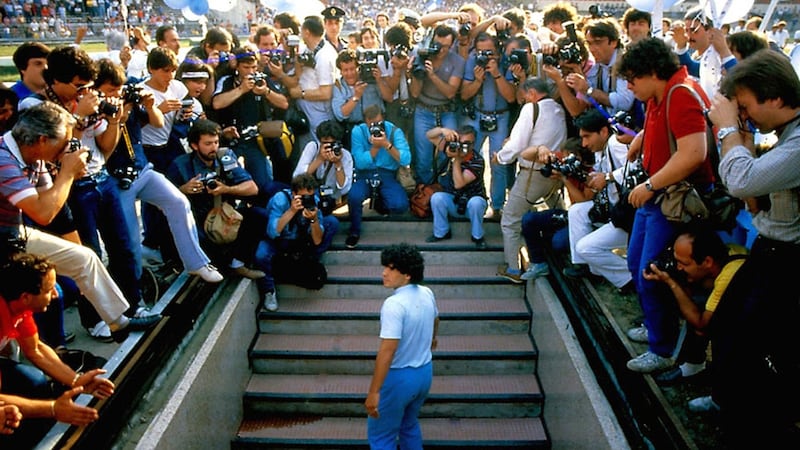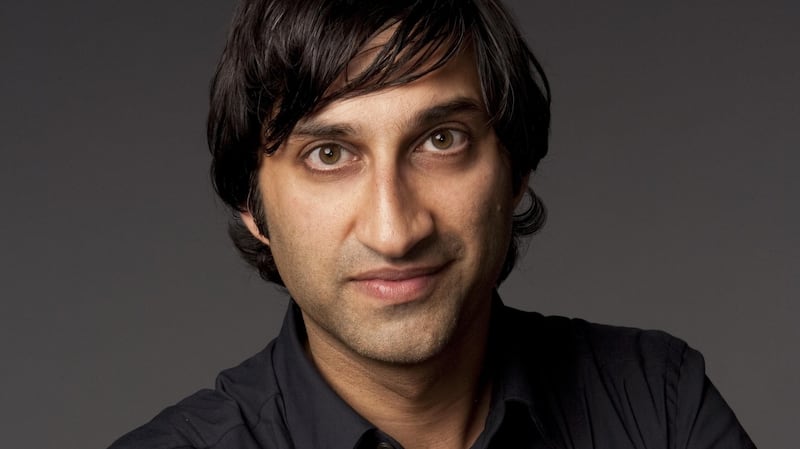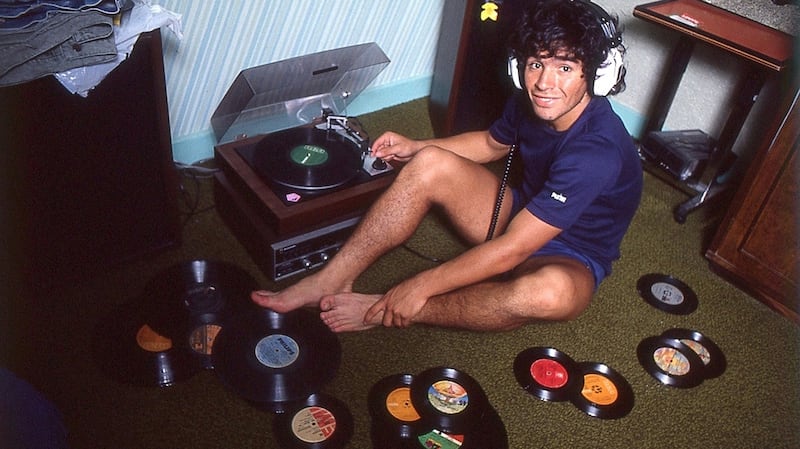Diego Maradona, a documentary portrait of the inimitable Argentine footballer, starts as it means to go on: with a riot, as a rally of Fiats roar up to Naples’ Stadio San Paolo for Maradona’s first Italian press conference. The opening question concerns the record-breaking £6.9 million (€7.85 million) fee: the poorest city in Europe has just bought the most expensive player in the world. Napoli club president Corrado Ferlaino starts shouting that he is “truly mortified” at the suggestion that Camorra money was involved. Fans cheer through the vents. A rapid montage touches on the number 10’s troubled career at Barcelona.
It’s absolute bedlam.
“He’s a hurricane,” says the film’s director, Asif Kapadia. “There’s always chaos around him. There is a pattern of death and resurrection throughout his life. He arrives; everybody loves him; he gets into a fight; things go bad; he leaves and goes somewhere new. And he’s off. He’s a hero again.”
'The fact that Naples never won anything without Diego is part of his legacy. It's part of what makes his story so special'
Maradona’s time at Napoli fits that cycle perfectly. It was an unlikely transfer, but everything about the number 10 – from his emergence from the Villa Fiorito shantytown outside Buenos Aires, to an anti-athletic physique that recalls the myth that bumblebees should not be able to fly – is improbable at best.
The footballer went on with that club to win the league (twice), the Coppa Italia, the Uefa Cup and the Italian Supercup. Between trophies, Maradona developed a crippling cocaine addiction, fathered a son he didn’t acknowledge until 2004, and hobnobbed with the Camorrista Giuliano family.
“Napoli seemed a very strange choice at that time for Maradona,” football historian John Foot explains in Kapadia’s thrilling documentary. “Serie A was the richest, most powerful league in the world… Napoli had never won the championship. It was not a successful team. It was not a team that was looking like being successful.”

The legacy
“They had almost been relegated the season before he arrived,” says Kapadia, of the current La Liga runners-up. “They survived on the last day. He could have headed into a second-division team. He literally didn’t know where he was going. There’s a big fan base of loyal fans in Naples. But the team were not very good and they had no money behind them. And he comes along and changes everything.
“I remember when I was editing our film, I was quite conflicted because I’ve got to know a lot of Neapolitans; they’re my team in Italy and I wanted them to win. But the fact that they’ve never won anything without Diego is part of his legacy. It’s part of what makes his story so special.”
But only part. Maradona, the fifth of seven children (and his mother’s favourite) was born into unimaginable poverty in 1960. He made his professional debut 10 days before his 16th birthday and his first international appearance (against Hungary) some months later. He played in four World Cup tournaments. He was suspended for 15 months in 1991 for cocaine use and failed another drug test during the 1994 World Cup in the US. (Maradona blamed the positive result on an energy drink). He credits Fidel Castro with getting him clean.
'He's never been a lovable person. I don't think he wants to be lovable person. He needs love but he also pushes people away. He's a tricky character'
His football record – even factoring in his celebrated “Hand of God” goal against England in 1986 or his all-out brawl against Bilbao in the 1984 Copa del Rey final – is unrivalled. He was named Fifa Player of the Century, along with Pelé, in 2000. (Maradona won the internet poll with 53.6 per cent of the vote, compared to Pelé’s 18.53 per cent.)
Off the pitch, he has proved, well, divisive. He was given a suspended jail sentence in 1998 for shooting journalists with an air rifle four years earlier. At the time of writing, his lawyer had recently acknowledged four children sired by the former footballer in Cuba. Maradona, who is currently the manager of Mexican second-division side Dorados has, additionally, just told FourFourTwo magazine that “If Manchester [United] need a coach, I’m the man to do it”. Last year, he offered to coach Napoli.
“Diego has some really dark things in his life,” says Kapadia, who notes that he never fell in love with Maradona the way he did with previous documentary subjects, including Amy Winehouse. “He’s never been a lovable person. I don’t think he wants to be lovable person. He needs love but he also pushes people away. He’s a tricky character. There’s a sadness about him. He’s a complex person that has a complex life. He’s also a really tough person to make a movie about. I mean both as a story and also to deal with his entourage and people. I feel like it’s a mad achievement if you can come close, and hopefully we have come close.”

‘True fiction’
If anyone could come close, it’s Kapadia. A football fan and Liverpool supporter (he has just returned from the Champions League final in Madrid for our interview), the North Londoner emerged from award-winning feature filmmaking (The Warrior, Far North) to pioneer archival-based “true fiction” cinema. His works include Senna, a portrait of Formula 1 driver Ayrton Senna (who died in a racing accident at 34) and Amy, which won an Academy Award and Grammy Award in 2016 and became the highest-grossing documentary of all time in the UK and Ireland. Maradona is the only one of Kapadia’s “true fiction” subjects who is still alive.
“It was a different experience but I was glad to have a different experience,” says the film-maker. “It was definitely a new challenge. As we were making a film about Diego Maradona that meant that anyone that we wanted to speak to would want to know that Diego was on board – even the people who haven’t spoken to him in 30 years – would worry about upsetting him.
'I would meet one guy one day and a different the next. He created this almost schizophrenic persona to survive. From a young age he talked about Maradona in the third person'
“So I had to interview Diego. So here is this person, this incredibly famous person, who’s still going and still creating chaos. My previous films had sad and tragic endings. But he is still going. He has never really retired quietly. So that was always a challenge. How does this film end? How do we tie things up? He’s still out there and changing his story constantly. Is the person that I’m interviewing actually the same person that I’m making a film about? Sometimes a person is the least reliable witness to their own life. I would meet him one day and the next day he’d say the opposite thing and he’d be adamant that was the truth.”
Kapadia was initially approached about making a Maradona movie in 2012. A producer, Paul Martin, had unearthed hundreds of hours of extraordinary footage shot on U-matic video between 1981 and 1987. Jorge Cyterszpiler, Maradona’s agent – the man who brokered the deal that brought the footballer to Camp Nou, landed contracts with Coca-Cola, Agfa, and McDonalds, and who unsuccessfully attempted to fix Maradona up with Princess Caroline of Monaco – had hoped that the footage could be used to create a world-conquering blockbuster.
“It was a really crazy idea,” says Kapadia. “But Diego had this manager and agent who was his friend from when they were kids. He was his first agent. He did the deals to get him to Boca Juniors and then to Barcelona and then to Napoli. Just before he went to Barcelona, Cyterszpiler had this idea that should be making a feature film about Maradona. He’s a massive star and he wanted him to break America. So he hired two Argentinian cameraman to follow Diego during the Barcelona years and when Barcelona didn’t work out very well, they followed him to Naples. So these two guys would shoot on the pitch and they shot all the personal stuff, at home and at parties. Then the agent got fired by Diego and the film was never made.
“We found the tapes in various parts of the world. Half of it was an hour outside of Naples. We found the other half in a trunk at Diego’s ex-wife’s home in Buenos Aires. So it was a real jigsaw puzzle. If you look, for example, at the opening sequence when you see his car arriving in Naples, that footage was in Naples, but the reverse shot, when you see him getting out and greeting the crowd, was in Buenos Aires.”

‘Internal conflict’
Aside from the footage, Kapadia found a second organising principle in something that Fernando Signorini, Maradona’s long-time trainer, suggested: that Diego and Maradona were two very different entities.
“I wanted to get across this idea of internal conflict,” says Kapadia. “And it was his trainer who said it first talked about two different people. And then I talked to other people. And they’d say I wish the guy I knew was still around. And that makes sense to me. I would meet one guy one day and a different guy the next. He created this almost schizophrenic persona in order to survive. From a very young age he talked about Maradona in the third person: Maradona wanted this, Maradona’s going to win this. So there’s a person on camera and there’s another person. I’ve met that person. He’s really charming and sweet and he’s got beautiful eyes. I love hanging around with this person.”
'He did say: "You know you've got a real nerve asking me these questions to my face". And then there was a long pause before he said: "But I respect you for that".'
There were, perhaps unsurprisingly, additional complications with the interviewing process. Maradona was a fan of Kapadia’s Senna and was in negotiations at the moment when the director scored an Oscar with Amy. But that didn’t necessarily make for a compliant or easy subject. Travelling to Dubai, where Maradona was based during production, the director had a varied experience.
“People might think there would be no-go areas but there were no no-go areas and there was no PR person to say ‘don’t bring this up’,” says Kapadia. “It was only once I sat down with him that I found out what was okay and what wasn’t okay.
“During the first meeting he wasn’t in a great place, he was tired, he wasn’t feeling well and I’m worried how much he remembers from 30 years ago. So I have my easy questions list. And he was like: ‘Don’t bring her up, I don’t want to hear about her’. So then I brought up someone else and he said: ‘Never mention that name again’.
“So I wait until the penultimate interview to deal with the heavy stuff. Because I have to make a movie and I don’t want him calling me a pancake like he did with the journalist in the film. He’s a genius interviewee. He has been doing this since he was 15. But he is used to going off on a tangent and dropping some brilliant line about Sepp Blatter or something so that the journalist has their headline.
“So I’d have to keep coming back to the issues I want to deal with. And at one point he got a bit annoyed and he did say: ‘You know you’ve got a real nerve asking me these questions to my face’. And then there was a long pause – that was even longer because I’m waiting for the translator – before he said: ‘But I respect you for that’.”
Kapadia was not shocked when Maradona, citing a shoulder injury, failed to turn up on the red carpet of the film’s Cannes premiere.
“How can you be surprised by anything Diego does?” laughs the director. “You can’t make Diego do anything. it has to be all his idea. I probably should have said: whatever you do don’t be in Cannes on this date. Then he might have turned up.”
Diego Maradona is released on June 14th





















